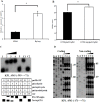The KP1_4563 gene is regulated by the cAMP receptor protein and controls type 3 fimbrial function in Klebsiella pneumoniae NTUH-K2044
- PMID: 28732013
- PMCID: PMC5521740
- DOI: 10.1371/journal.pone.0180666
The KP1_4563 gene is regulated by the cAMP receptor protein and controls type 3 fimbrial function in Klebsiella pneumoniae NTUH-K2044
Abstract
Klebsiella pneumoniae (K. pneumoniae) is an opportunistic pathogen that can adhere to host cells or extracellular matrix via type 1 and type 3 fimbriae. KP1_4563 is a gene encoding a hypothetical protein in K. pneumoniae NTUH-K2044. KP1_4563 is located between the type 1 and type 3 fimbrial gene clusters and is likely associated with fimbrial function given its putative conserved domains of unknown function (DUF1471). Cyclic AMP receptor protein (CRP) regulates virulence-related gene expression and is a crucial transcriptional regulator in many bacteria. The predicted DNA recognition motif of CRP is present in the KP1_4563 promoter region. This study aimed to investigate the function of KP1_4563 in fimbriae and its transcriptional regulation mechanism by CRP. We generated Kp-Δ4563 mutant and complementation strains. We utilized phenotype and adhesion assays to evaluate the role of KP1_4563 in fimbriae. We conducted quantitative RT-PCR (qRT-PCR), LacZ fusion, electrophoretic mobility shift, and DNase I footprinting assays to study the transcriptional regulation of KP1_4563 gene by CRP. We found that KP1_4563 negatively regulates the function of type 3 fimbriae. Compared with NTUH-K2044, the absence of KP1_4563 enhanced the ability of Kp-Δ4563 to adhere to A549 cells. CRP negatively regulates KP1_4563 by directly binding to its promoter region. KP1_4563 plays an important role in type 3 fimbrial function. This novel insight will assist in the development of strategies for preventing K. pneumoniae infection.
Conflict of interest statement
Figures


Similar articles
-
Influence of cAMP receptor protein (CRP) on bacterial virulence and transcriptional regulation of allS by CRP in Klebsiella pneumoniae.Gene. 2016 Nov 15;593(1):28-33. doi: 10.1016/j.gene.2016.08.006. Epub 2016 Aug 5. Gene. 2016. PMID: 27502416
-
A protein containing the DUF1471 domain regulates biofilm formation and capsule production in Klebsiella pneumoniae.J Microbiol Immunol Infect. 2022 Dec;55(6 Pt 2):1246-1254. doi: 10.1016/j.jmii.2021.11.005. Epub 2021 Dec 6. J Microbiol Immunol Infect. 2022. PMID: 34924339
-
Positive autoregulation of mrkHI by the cyclic di-GMP-dependent MrkH protein in the biofilm regulatory circuit of Klebsiella pneumoniae.J Bacteriol. 2015 May;197(9):1659-67. doi: 10.1128/JB.02615-14. Epub 2015 Mar 2. J Bacteriol. 2015. PMID: 25733612 Free PMC article.
-
The Fructose-Specific Phosphotransferase System of Klebsiella pneumoniae Is Regulated by Global Regulator CRP and Linked to Virulence and Growth.Infect Immun. 2018 Jul 23;86(8):e00340-18. doi: 10.1128/IAI.00340-18. Print 2018 Aug. Infect Immun. 2018. PMID: 29844239 Free PMC article.
-
Regulation of ECP fimbriae-related genes by the transcriptional regulator RcsAB in Klebsiella pneumoniae NTUH-K2044.J Basic Microbiol. 2022 May;62(5):593-603. doi: 10.1002/jobm.202100595. Epub 2022 Feb 8. J Basic Microbiol. 2022. PMID: 35132658
Cited by
-
EtcABC, a Putative EII Complex, Regulates Type 3 Fimbriae via CRP-cAMP Signaling in Klebsiella pneumoniae.Front Microbiol. 2019 Jul 9;10:1558. doi: 10.3389/fmicb.2019.01558. eCollection 2019. Front Microbiol. 2019. PMID: 31354661 Free PMC article.
-
The effect of a temperature-sensitive prophage on the evolution of virulence in an opportunistic bacterial pathogen.Mol Ecol. 2022 Oct;31(20):5402-5418. doi: 10.1111/mec.16638. Epub 2022 Sep 17. Mol Ecol. 2022. PMID: 35917247 Free PMC article.
-
RcsAB and Fur Coregulate the Iron-Acquisition System via entC in Klebsiella pneumoniae NTUH-K2044 in Response to Iron Availability.Front Cell Infect Microbiol. 2020 Jun 10;10:282. doi: 10.3389/fcimb.2020.00282. eCollection 2020. Front Cell Infect Microbiol. 2020. PMID: 32587833 Free PMC article.
-
Intestinal carbapenem-resistant Klebsiella pneumoniae undergoes complex transcriptional reprogramming following immune activation.Gut Microbes. 2024 Jan-Dec;16(1):2340486. doi: 10.1080/19490976.2024.2340486. Epub 2024 Apr 24. Gut Microbes. 2024. PMID: 38659243 Free PMC article.
References
-
- Barbadoro P, Labricciosa FM, Recanatini C, Gori G, Tirabassi F, Martini E, et al. Catheter-associated urinary tract infection: Role of the setting of catheter insertion. AM J INFECT CONTROL. 2015; 43(7): 707–10. doi: 10.1016/j.ajic.2015.02.011 - DOI - PubMed
-
- Ko WC, Paterson DL, Sagnimeni AJ, Hansen DS, Von Gottberg A, Mohapatra S, et al. Community-acquired Klebsiella pneumoniae bacteremia: global differences in clinical patterns. EMERG INFECT DIS. 2002; 8(2): 160–6. doi: 10.3201/eid0802.010025 - DOI - PMC - PubMed
-
- Chang CC, Lu CH, Huang CR, Chuang YC, Tsai NW, Chen SF, et al. Culture-proven bacterial meningitis in elderly patients in southern Taiwan: clinical characteristics and prognostic factors. Acta Neurol Taiwan. 2006; 15(2): 84–91. - PubMed
-
- Luo M, Yang XX, Tan B, Zhou XP, Xia HM, Xue J, et al. Distribution of common pathogens in patients with pyogenic liver abscess in China: a meta-analysis. Eur J Clin Microbiol Infect Dis. 2016; 35(10): 1557–1565. doi: 10.1007/s10096-016-2712-y - DOI - PMC - PubMed
-
- Yadav KK, Awasthi S. The current status of community-acquired pneumonia management and prevention in children under 5 years of age in India: a review. Ther Adv Infect Dis. 2016; 3(3–4): 83–97. doi: 10.1177/2049936116652326 - DOI - PMC - PubMed
MeSH terms
Substances
LinkOut - more resources
Full Text Sources
Other Literature Sources
Molecular Biology Databases
Research Materials
Miscellaneous

